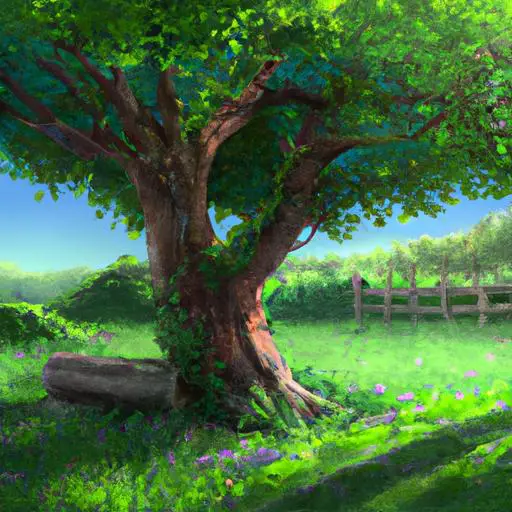Do you have an elm tree in your yard? Are you concerned that it might be dying? If so, it’s important to take action quickly.
Knowing the signs of a dying elm tree and understanding the potential causes can help you take the right steps to save it.
In this article, we’ll explore the signs of a dying elm tree, the potential causes, and the steps you can take to treat and protect your elm tree.
We’ll also discuss the environmental factors that can affect an elm tree’s health.
Read on to find out how to determine if your elm tree is at risk and what you can do to save it.
Table of Contents
Short Answer
It is difficult to tell without inspecting the tree in person, however there are some signs that can indicate whether your elm tree is dying.
Look for changes in the color of the leaves such as yellowing, browning, or wilting.
Check for any discoloration in the bark or for mushrooms growing near the base of the tree.
If you notice any of these signs, it could be an indication that your elm tree is in distress.
Signs of a Dying Elm Tree
If you suspect your elm tree is in danger, it is important to look for signs of a dying tree.
One common sign is yellowing leaves.
This can be caused by a variety of factors, including disease, pests, environmental conditions, or soil issues.
You may also note a decrease in the amount of foliage and bare branches.
Discolored bark is another sign of a dying elm tree.
It may appear to have patches of gray or black, which could indicate an infection or other issue.
It is important to take action as soon as you notice any of these signs, as the tree may not recover without prompt attention.
Possible causes of a dying elm tree include disease, pests, soil issues, or environmental factors.
In some cases, it may be necessary to consult an arborist to assess the tree and determine the best course of action.
By addressing the underlying issue quickly, you can prevent the tree from dying.
Causes of a Dying Elm Tree

There are several possible causes of a dying elm tree, and it is important to identify the cause in order to determine the best course of action.
Common causes of a dying elm tree include disease, pests, soil issues, and environmental factors.
Disease is a common culprit of a dying elm tree.
Dutch elm disease is a fungal disease spread by bark beetles that can cause the leaves to yellow and the tree to wilt.
Other diseases such as verticillium wilt and phloem necrosis can also cause discoloration and wilting of the leaves.
Pests can also be a cause of a dying elm tree.
Insects such as bark beetles can feed on the bark of the tree and damage its structure, leading to a weakened tree.
Other pests such as aphids, mites, and scale can feed on the sap of the tree, depriving it of essential nutrients and leading to a weakened tree.
Soil issues can also lead to a dying elm tree.
Poor drainage can cause the tree to become waterlogged, leading to root rot and the eventual death of the tree.
Soil compaction can also lead to a weakened tree, as the roots are unable to penetrate the compacted soil and access essential nutrients.
Finally, environmental factors can cause a dying elm tree.
Severe weather such as drought and extreme temperatures can lead to a weakened tree.
Additionally, too much or too little sunlight can cause the tree to become stressed, leading to a weakened tree.
Identifying the cause of a dying elm tree is essential in order to determine the best course of action.
For this reason, it is often necessary to consult an arborist in order to assess the tree and identify the cause.
The arborist can then provide advice on how to best treat the tree and prevent it from dying.
The Importance of Taking Action Quickly
When it comes to a dying elm tree, it is important to take action quickly to prevent the tree from dying.
If you notice any signs of a dying elm tree, such as yellowing leaves, bare branches, and discolored bark, you should take steps to assess the tree and determine the best course of action as soon as possible.
The sooner you take action, the more likely it is that you will be able to save the tree.
There are several possible causes of a dying elm tree, such as disease, pests, soil issues, or environmental factors.
Without taking action quickly, the tree may not be able to recover and may die.
If the tree is already in a weakened state, any of these causes can become a fatal blow.
In some cases, it may be necessary to consult an arborist to assess the tree and determine the best course of action.
An arborist is a trained professional who is familiar with tree health and can provide advice on how to best care for your elm tree.
They can also help to diagnose any diseases or pests that may be present in the tree.
If you believe your elm tree may be dying, it is important to take action quickly.
Try to identify any possible causes and take steps to address them.
If necessary, consult an arborist who can provide expert advice on how to best care for your tree.
Taking action quickly can help to prevent the tree from dying and may even help to save it from further damage.
Treating a Diseased Elm Tree

If your elm tree is suffering from a disease, it is important to identify the source and take action quickly to save the tree.
Common diseases that affect elm trees include Dutch elm disease, elm yellows, and elm scale.
Dutch elm disease is a fungal disease that is spread by elm bark beetles and can cause the tree to become weak and die.
Elm yellows is a type of phytoplasma disease that is spread by leafhoppers and can cause yellowing leaves and bare branches.
Elm scale is a type of scale insect that feeds on the tree’s sap and can cause discolored bark and leaf drop.
In order to treat a diseased elm tree, it is important to first identify the source of the problem.
If you suspect your tree may be suffering from a disease, it is best to contact an arborist to inspect the tree and determine the best course of action.
Depending on the severity of the disease, the arborist may recommend removing the tree or treating it with fungicides, insecticides, or other treatments.
It is important to follow the arborist’s instructions carefully in order to ensure the best chance of saving the tree.
Additionally, it is important to prune any dead or damaged branches to improve the tree’s overall health.
Preventing Pests From Killing an Elm Tree
The health of an elm tree can be easily threatened by pests, such as aphids, scale insects, borers, and bark beetles.
Keeping pests away from the tree is key to preventing it from dying.
Regularly inspecting the tree for signs of pests is essential.
A good way to do this is to look for discolored, deformed, or damaged leaves.
If you suspect an infestation, it is important to act quickly to prevent further damage.
One way to prevent pests from killing an elm tree is to use organic methods.
This includes using beneficial insects, such as ladybugs or lacewings, to naturally control the population of pests.
You can also use horticultural oils or insecticidal soaps to eradicate pests.
Additionally, keeping the tree well-watered and pruned can help prevent pests from taking hold.
If you have an elm tree in your yard, it is important to take steps to prevent it from dying due to pests.
Regularly inspecting the tree for signs of an infestation and taking action quickly can help prevent a major problem from occurring.
Additionally, using organic methods, such as beneficial insects, horticultural oils, and insecticidal soaps can help keep pests away from the tree.
By taking these steps, you can help keep your elm tree healthy and ensure it stays alive for many years to come.
Ensuring the Soil is Suitable for an Elm Tree

If you’re trying to determine if your elm tree is dying, the first thing to check is the soil.
Elm trees need well-draining soil that is slightly acidic.
If the soil is too wet or too dry, it can cause stress to the tree, leading to yellowing leaves or bare branches.
Additionally, if the soil is too alkaline, it can cause the tree to be unable to absorb the nutrients it needs to survive.
The best way to determine if your soil is suitable for an elm tree is to take a soil sample and have it tested.
This will tell you the pH level of the soil and whether or not it is providing the right nutrients for the tree.
You can also use a home soil testing kit to test the pH level yourself.
If the soil is too alkaline, you may need to add organic matter or sulfur to the soil to lower the pH level.
In addition to the pH level, it’s important to make sure the soil is well-draining.
If the soil is too wet, the roots may be unable to get the oxygen they need, leading to root rot and other issues.
To check the soil’s drainage, dig a hole about 6 inches deep and fill it with water.
If the water drains away within an hour, the soil is well-draining.
If it takes longer than an hour, you may need to add sand or gravel to the soil to improve drainage.
By making sure the soil is suitable for an elm tree, you can prevent many of the issues that can lead to a dying tree.
Take the time to check the soil before assuming your elm tree is dying, and you may be able to save it.
Environmental Factors That Can Affect an Elm Tree
Environmental factors can play an important role in the health of an elm tree, and its important to be aware of them when trying to determine if your tree is dying.
Unfavorable weather conditions, such as extreme temperatures, drought, and flooding can all take their toll on an elm tree.
Damage from strong winds, storms, or hail can also be harmful, as can inadequate sunlight and too much direct sunlight.
In addition, soil compaction or poor drainage can cause an elm tree to struggle, and nearby construction or landscaping can cause damage to the trees roots.
If you suspect environmental factors are affecting your elm tree, the first step is to assess the trees surroundings.
Make sure the tree is in an area that is suitable for its species, and that there is enough space for the tree to grow.
Check that the soil is not too wet or too dry, and that the tree is not receiving too much direct sunlight.
If necessary, you may need to make some changes to the trees environment, such as providing more shade or altering the irrigation.
An arborist can help you determine the best course of action.
Final Thoughts
If youve noticed your elm tree isnt doing well, its important to take action quickly to diagnose the problem.
There are a variety of potential causes, including disease, pests, soil issues, and environmental factors.
Knowing the signs of a dying elm tree is the first step in taking action.
If you’re unsure how to proceed, its best to consult an arborist who can assess the tree and determine the best course of action.
Dont let your elm tree die – take action now!


